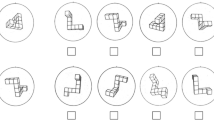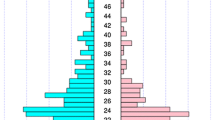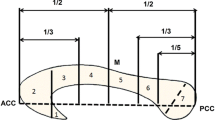Abstract
Mental rotation is a cognitive process that involves performing rotations on visual images or objects, which has played a significant role in humans’ evolutionary past. Sex differences in mental rotation ability have been extensively assessed using the Vandenberg and Kuse (1978) Mental Rotations Test. This test produces consistently higher scores for men than women, which has led numerous researchers to conclude that males have superior mental rotation ability. The causes of this sex difference have been widely debated, and research remains inconclusive. Various researchers have challenged the legitimacy of this male advantage by investigating moderating factors that are part of the assessment process. Here we show, through the use of photographs and three-dimensional models, that the form of the stimuli can eliminate the sex difference. Our results suggest that the sex difference found on this test is not due to a male advantage in spatial ability, but is an artifact of the stimuli.

Similar content being viewed by others
References
Annett, M. (1992). Spatial ability in subgroups of left- and right-handers. British Journal of Psychology, 47, 730–747.
Boone, A. P., & Hegarty, M. (2017). Sex differences in mental rotation tasks: not just in the mental rotation process! Journal of Experimental Psychology: Learning, Memory, and Cognition, 43(7), 1005–1019.
Daly, M., & Wilson, M. (2001). Risk-taking, intrasexual competition, and homicide. Nebraska Symposium on Motivation, 47, 1–36.
Estes, Z., & Felker, S. (2012). Confidence mediates the sex difference in mental rotation performance. Archives of Sexual Behavior, 41, 557–570.
Fisher, M., Cox, A., & Zhao, L. (2006). Using sex differences to link spatial cognition and program comprehension. Proceedings of the IEEE International Conference on Software Maintenance, 289–298.
Gallagher, A., & De Lisi, R. (1994). Gender differences in scholastic aptitude test—mathematics problem solving among high-ability students. Journal of Educational Psychology, 86, 204–211.
Gardony, A. L., Taylor, H. A., & Brunyé, T. T. (2013). What does physical rotation reveal about mental rotation? Psychological Science, 25(2), 605–612. https://doi.org/10.1177/0956797613503174.
Gaulin, S. J., & FitzGerald, R. W. (1989). Sexual selection for spatial learning ability. Animal Behavior, 37, 322–331.
Geary, D. C. (1995). Sexual selection and sex differences in spatial cognition. Learning and Individual Differences, 7, 289–301.
Geary, D. C., Gilger, J. W., & Elliot-Miller, B. (1992). Gender differences in three-dimensional mental rotation: a replication. Journal of Genetic Differences, 153, 115–117.
Gentaz, E., & Hatwell, Y. (1995). The haptic “oblique effect” in children’s and adults’ perception of orientation. Perception, 24, 631–646.
Goldstein, D., Haldane, D., & Mitchell, C. (1990). Sex differences in visual-spatial ability: the role of performance factors. Memory & Cognition, 18, 546–550.
Gur, R. C., Alsop, D., Glahn, D., Petty, R., Swanson, C. L., Maldjian, J. A., Turetsky, B. I., Detre, J. A., Gee, J., & Gur, R. E. (2000). An fMRI study of sex differences in regional activation to a verbal and spatial task. Brain and Language, 74, 157–170.
Halpern, D. F. (2012). Sex differences in cognitive abilities (4th ed.). NY: Psychology Press.
Hedges, L. V., & Nowell, A. (1995). Gender differences in mental test scores, variability and numbers of high-scoring individuals. Science, 269, 41–45.
Helgeson, V. (2005). Psychology of gender (2nd ed.). Upper Saddle River: Prentice-Hall.
Hirnstein, M., Bayer, U., & Hausmann, M. (2009). Sex-specific response strategies in mental rotation. Learning and Individual Differences, 19(2), 225–228.
Jansen, P., Zayed, K., & Osmann, R. (2016). Gender differences in mental rotation in Oman and Germany. Learning and Individual Differences, 51, 284–290.
Kaufman, S. B. (2007). Sex differences in mental rotation and spatial visualization ability: can they be accounted for by differences in working memory capacity? Intelligence, 35, 211–223. https://doi.org/10.1016/j.intell.2006.07.009.
Kaushall, P., & Parson, L. M. (1981). Optical information and practice in the discrimination of three-dimensional objects. Canadian Journal of Psychology, 46, 170–190.
Kimura, D. (1999). Sex and cognition. Cambridge: MIT Press.
Linn, M. C., & Peterson, A. C. (1985). Emergence and characterization of gender differences in spatial abilities: a meta-analysis. Child Development, 56, 1479–1498.
Masters, M. S. (1998). The gender difference on the Mental Rotations Test is not due to performance factors. Memory and Cognition, 26, 444–448.
Masters, M. S., & Sanders, B. (1993). Is the gender difference in mental rotation disappearing? Behavior Genetics, 23, 337–341.
Maccoby, E. E., & Jacklin, C. N. (1974). Psychology of sex differences. Stanford: Stanford University Press.
McWilliams, W., Hamilton, C. J., & Muncer, S. J. (1997). On mental rotation in three dimensions. Perceptual and Motor Skills, 85, 297–298.
Moè, A. (2016). Teaching motivation and strategies to improve mental rotation abilities. Intelligence, 59, 16–23.
Moreau, D., Clerc, J., Mansy-Dannay, A., & Guerrien, A. (2012). Enhancing spatial ability through sport practice: evidence for an effect of motor training on mental rotation performance. Journal of Individual Differences, 33, 83–88. https://doi.org/10.1027/1614-0001/a000075.
Moreau, D., Mansy-Dannay, A., Clerc, J., & Guerrien, A. (2010). Academic program and mental rotation performance: evidence for a developmental effect on individual differences in early adulthood. GESJ: Education Science and Psychology, 2(17), 21–28.
Nazareth, A., Herrera, A., & Pruden, S. M. (2013). Explaining sex differences in mental rotation: role of spatial activity experience. Cognitive Processing, 14(2), 201–204.
Parsons, L. M. (1995). Inability to reason about an object’s orientation using an axis and angle of rotation. Journal of Experimental Psychology: Human Perception and Performance, 21, 1259–1277.
Parsons, T. D., Larson, P., Kratz, K., Thiebaux, M., Bluestein, B., Buckwalter, J. G., & Rizzo, A. A. (2004). Sex differences in mental rotation and spatial rotation in a virtual environment. Neuropsychologia, 42(4), 555–562.
Pazzaglia, F., & Moè, A. (2013). Cognitive styles and mental rotation ability in map learning. Cognitive Processing, 14(4), 391–399. https://doi.org/10.1007/s10339-013-0572-2.
Peters, M. (2005). Sex differences and the factor of time in solving Vandenberg and Kuse mental rotation problems. Brain and Cognition, 57, 176–184.
Pletzer, B. (2014). Sex-specific strategy use and global-local processing: a perspective toward integrating sex differences in cognition. Frontiers in Neuroscience, 8, 425. https://doi.org/10.3389/fnins.2014.00425.
Resnick, S. (1993). Sex differences in mental rotations: an effect of time limits? Brain and Cognition, 21, 71–79.
Robert, M., & Chevrier, E. (2003). Does men’s advantage in mental rotation persist when real three-dimensional objects are either felt or seen? Memory and Cognition, 31, 1136–1145.
Saucier, D. M., McCreary, D. R., & Saxberg, J. K. J. (2002). Does gender role socialization mediate sex differences in mental rotations? Personality and Individual Differences, 32, 1101–1111.
Shepard, R., & Metzler, J. (1971). Mental rotation of three-dimensional objects. Science, 171, 701–703.
Silverman, I., Choi, J., Mackewn, A., Fisher, M., Moro, J., & Olshansky, E. (2000). Evolved mechanisms underlying wayfinding: further studies on the hunter-gatherer theory of spatial sex differences. Evolution and Human Behavior, 21(3), 201–213.
Silverman, I., & Phillips, K. (1993). Effects of estrogen changes during the menstrual cycle on spatial performance. Ethology and Sociobiology, 14, 257–270.
Symons, D. (1979). The evolution of human sexuality. Oxford: Oxford University Press.
Turkle, S., & Papert, S. (1990). Epistemological pluralism: styles and voices within the computer culture. Signs, 16, 128–157.
Vandenberg, S. G., & Kuse, A. R. (1978). Mental rotations, a group test of three-dimensional spatial visualization. Perceptual and Motor Skills, 47, 599–604.
Vashro, L., & Cashdan, E. (2015). Spatial cognition, mobility, and reproductive success in northwestern Namibia. Evolution and Human Behavior, 36(2), 123–129.
Voyer, D. (1997). Scoring procedure, performance factors and magnitude of sex differences in spatial performance. American Journal of Psychology, 110, 259–276.
Voyer, D., & Hou, J. (2006). Type of items and the magnitude of gender differences on the Mental Rotations Test. Canadian Journal of Experimental Psychology, 60, 91–100.
Voyer, D., Nolan, C., & Voyer, S. (2000). The relation between experience and spatial performance in men and women. Sex Roles, 43, 891–915.
Voyer, D., & Saunders, K. (2004). Gender differences on the mental rotations test: a factor analysis. Acta Psychologia, 117, 79–94.
Voyer, D., Voyer, S., & Bryden, M. P. (1995). Magnitude of sex differences in spatial abilities: a meta-analysis and consideration of critical variables. Psychological Bulletin, 117, 250–270.
Wohlschälger, A., & Wohlschälger, A. (1998). Mental and manual rotation. Journal of Experimental Psychology: Human Perception and Performance, 24, 397–412.
Author information
Authors and Affiliations
Corresponding author
Rights and permissions
About this article
Cite this article
Fisher, M.L., Meredith, T. & Gray, M. Sex Differences in Mental Rotation Ability Are a Consequence of Procedure and Artificiality of Stimuli. Evolutionary Psychological Science 4, 124–133 (2018). https://doi.org/10.1007/s40806-017-0120-x
Published:
Issue Date:
DOI: https://doi.org/10.1007/s40806-017-0120-x




